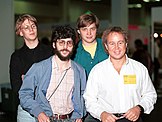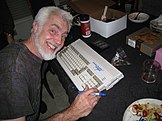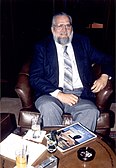Selected biography 1
Portal:Amiga/Selected biography/1

The Fish Disks were distributed at computer stores and Commodore Amiga enthusiast clubs. Contributors submitted applications and source code and the best of these each month were assembled and released as a diskette. Since the Internet was not yet in popular usage outside military and university circles, this was a primary way for enthusiasts to share work and ideas. He also initiated the "GeekGadgets" project, a GNU standard environment for AmigaOS and BeOS. (Full article...)
Selected biography 2
Portal:Amiga/Selected biography/2
Robert J. "RJ" Mical (born 26 January) is a pioneer and an influential figure in the video game industry. He created video games at Williams Electronics, helped invent the Amiga computer, co-invented the Atari Lynx and the 3DO Interactive Multiplayer with Dave Needle. He was the central developer of Amiga's Intuition user interface and was well known at early Amiga gatherings. Mical was the Chief Architect of the Fathammer mobile game engine. From 2005 to 2011 he worked as a Senior Manager at Sony on the PlayStation product line. Since 2011 he has been working on software games and inventions with his own company, Arjinx. In 2012 he started working on game technology for Google. According to Mical he created his first electronic game, a tic-tac-toe player, when he was 14. (Full article...)Selected biography 3
Portal:Amiga/Selected biography/3
Jay Glenn Miner (May 31, 1932 – June 20, 1994) was an American integrated circuit designer, known primarily for developing multimedia chips for the Atari 2600 and Atari 8-bit family and as the "father of the Amiga". He received a BS in EECS from UC Berkeley in 1959.He moved to Atari in the late 1970s. However, in the early 1980s Jay, along with other Atari staffers, had become fed up with management and decamped. They set up another chipset project under a new company in Santa Clara, called Hi-Toro (later renamed to Amiga Corporation), where they could have creative freedom. There, they started to create a new Motorola 68000-based games console, codenamed Lorraine, that could be upgraded to a computer. To raise money for the Lorraine project, Amiga Corp. designed and sold joysticks and game cartridges for popular game consoles such as the Atari 2600 and ColecoVision, as well as an odd input device called the Joyboard, essentially a joystick the player stood on. Atari continued to be interested in the team's efforts throughout this period, and funded them with $500,000 in capital in return for first use of their resulting chipset. (Full article...)
Selected biography 4
Portal:Amiga/Selected biography/4
Carl Sassenrath (born 1957 in California) is an architect of operating systems and computer languages. He brought multitasking to personal computers in 1985 with the creation of the Amiga Computer operating system kernel, and he is currently the designer of the REBOL computer language as well as the CTO of REBOL Technologies.In the late 1960s his family relocated from the San Francisco Bay Area to the small town of Eureka, California. From his early childhood Sassenrath was actively involved in electronics, amateur radio, photography, and filmmaking. When he was 13, Sassenrath began working for KEET a PBS public broadcasting television station. A year later he became a cameraman for KVIQ (American Broadcasting Company affiliate then) and worked his way up to being technical director and director for news, commercials, and local programming. (Full article...)
Selected biography 5
Portal:Amiga/Selected biography/5 Daniel J. Barrett (born November 6, 1963) is a writer, software engineer, and musician. He is best known for his technology books, his work with progressive rock band Gentle Giant, and the imaginary computer game BLAZEMONGER.
Barrett has written a number of technical books on computer topics. The most well-known are Linux Pocket Guide and SSH, The Secure Shell: The Definitive Guide. His books have been translated into Czech, French, German, Hungarian, Italian, Japanese, Mandarin, Polish, Portuguese, Russian, and Spanish. (Full article...)
Selected biography 6
Portal:Amiga/Selected biography/6
Matt Bielby is a magazine editor based in the UK. He is best known for launching and editing many successful titles in assorted markets during the 1990s, mostly on the subjects of computer and video games, and film and television. These include .net, Amiga Power, Super Play and PC Gamer.Bielby was born in Huddersfield, West Yorkshire, in 1965, and spent most of his early life in Bradford, West Yorks, where he attended Bradford Grammar School. (Full article...)
Selected biography 7
Portal:Amiga/Selected biography/7 Timothy John Follin (born 19 December 1970) is a former video game music composer who has written tracks for a variety of titles and home gaming systems, including the ZX Spectrum, Commodore 64, Amiga, Atari ST, Nintendo Entertainment System, Super NES, Game Boy, Dreamcast and PlayStation.
Follin's early 8- and 16-bit pieces were notable for their ambitious and imaginative use of samples, or clever manipulation of limited sound hardware – particularly with his work on the Sinclair ZX Spectrum, on which he managed to play up to six channels of audio from one simple, tiny, clickable dynamic speaker.
Among Follin's works are the soundtracks to Ecco the Dolphin: Defender of the Future (Dreamcast), Silver Surfer (NES) and Spider-Man/X-Men: Arcade's Revenge (Super NES). (Full article...)
Selected biography 8
Portal:Amiga/Selected biography/8
Kieron Gillen (born 1975) is a British comic book writer and former computer game and music journalist. He is known for his creator-owned comics Phonogram and The Wicked + The Divine, both created with artist Jamie McKelvie and published by Image Comics, and for numerous projects for Marvel Comics, such as Journey into Mystery and Uncanny X-Men.Gillen has worked for publications such as PC Gamer UK, The Escapist, Amiga Power (under the pseudonym "C-Monster"), Wired, The Guardian, Edge, Games Developer, Develop, MCV, GamesMaster and PC Format, among others. (Full article...)
Selected biography 9
Portal:Amiga/Selected biography/9
Jon "Jops" Hare (born 20 January 1966, Ilford, Essex, England) is an English computer game designer, game artist and musician. He is one of the two founder members and directors, with Chris Yates, of Sensible Software, one of the most successful European games development companies of the late 1980s and 1990s.Hare was co-designer and artist of all of Sensible's hits prior to 1992 including Parallax, Wizball, Microprose Soccer, SEUCK and Wizkid. He was also the lead designer, composer and creative director of Mega Lo Mania, the Sensible Soccer series and the Cannon Fodder series, some of the most popular software franchises of the mid-1990s. (Full article...)
Selected biography 10
Portal:Amiga/Selected biography/10
Dave Haynie is the former Commodore International chief engineer on high end and advanced projects. He is still quite vocal in the Amiga community.He started work at Commodore in 1983 as an engineer under Bil Herd. His first project was to help complete the TED systems comprising Plus/4, C16 and more. After completing the Commodore 128 Bil Herd left the company and Dave Haynie was promoted to chief engineer in the low-end group. After Commodore acquired Amiga, Dave Haynie ended up primary engineer on the expandable A2000 computer. Later, he joined Bob Welland on the A2620 CPU module, and launched the follow-up A2630 the year thereafter. These were delivered in the A2500/20 (1989) and A2500/30 (1989). In 1989 he started designing the Zorro III expansion bus architecture, and in 1990, with Greg Berlin, Hedley Davis, Jeff Boyer, and Scott Hood, created the Amiga 3000. (Full article...)
Selected biography 11
Portal:Amiga/Selected biography/11
Chris Huelsbeck (also spelled Hülsbeck, born March 2, 1968) is a German video game music composer from Kassel, Germany.In 1986, Huelsbeck released the SoundMonitor program for Commodore 64 computer. The program was released as a type-in listing in the German computer magazine 64'er. Huelsbeck has written soundtracks for more than 70 titles, the latest being Giana Sisters: Twisted Dreams. Many of his scores for the Commodore 64 are regarded as classics among enthusiasts today, most notably The Great Giana Sisters. He is best known for the soundtracks to the Turrican series of games. Chris's initial recognition arrived at age 17 when his composition "Shades" won first place in a music competition for the German 64'er magazine. (Full article...)
Selected biography 12
Portal:Amiga/Selected biography/12
Richard Joseph (23 April 1953 – 4 March 2007) was a British computer game composer, musician and sound specialist. He had a career spanning 20 years starting in the early days of gaming on the C64 and the Amiga and onto succeeding formats.Richard was noted in game audio for bringing "real" voice actors into a game for the first time (Mega Lo Mania), the earliest use of interactive music (Chaos Engine), working with established recording artists (Betty Boo on Magic Pockets, Captain Sensible on Sensible Soccer, Brian May on Rise of the Robots and John Foxx on Gods and Speedball 2), and featuring vocals in title tunes, which was revolutionary for the time. (Full article...)
Selected biography 13
Portal:Amiga/Selected biography/13 François Lionet is a French programmer, best known for having written STOS BASIC on the Atari ST and AMOS BASIC on the Amiga and (along with Constantin Sotiropoulos). He has also written several games on these platforms.
In 1994, he founded Clickteam with Yves Lamoureux, producing the Klik series of games-creation tools, including Multimedia Fusion. (Full article...)
Selected biography 14
Portal:Amiga/Selected biography/14 David Shannon Morse (April 15, 1943 – November 2, 2007) was the cofounder of Amiga. In 1982, he left Tonka Toys (where he was Vice-President of Marketing) and became the Chief Executive Officer at Hi Toro, Inc., which he co-founded and which later that year morphed into Amiga, Inc. which he led through the development of the Lorraine Project (a codename inspired by David's wife Lorraine), ultimately, the Amiga 1000 computer. In the 1980s he was a software manager at Epyx, a video game developer and publisher. (Full article...)
Selected biography 15
Portal:Amiga/Selected biography/15 Jeremy "Jez" San OBE (born 29 March 1966) is an English game programmer and entrepreneur who founded Argonaut Software as a teenager in the 1980s. He is best known for the 1986 Atari ST game Starglider and helping to design the Super FX chip used in Star Fox for the Super NES.
San bought his first computer, a TRS-80, at age twelve. Within a year he taught himself assembly language for several microprocessors.
San founded Argonaut Software in 1982 as a way to get software consulting jobs with large companies. He worked on security systems with British Telecom and Acorn. In 1984, he started developing his first game, Skyline Attack for the Commodore 64, and also co-wrote a book, Quantum Theory, about the Sinclair QL. He became a wizard (admin) at Essex MUD, the world's first multiplayer online role-playing game. (Full article...)
Selected biography 16
Portal:Amiga/Selected biography/16
Petro Taras Ostap Tyschtschenko (born 16 April 1943 in Vienna) is an Austrian-born German businessman best known for his work in the European market for the American computer company Commodore International.Tyschtschenko first came into contact with Commodore in 1982, when he saw a job advertisement in a newspaper. Salomon+Schimmelmann, a German headhunter company, was looking for a new business administrator for Commodore. Tyschtschenko immediately signed up for a job interview, but was not hired. However, he later received a telephone call from Harald Speyer, the director of Commodore's German market, saying he would want to hire Tyschtschenko as a business administrator and wanted him to start as soon as possible. Tyschtschenko immediately resigned from his current job at the company Adressograph-Multigraph and joined Commodore the next day. (Full article...)
Selected biography 17
Portal:Amiga/Selected biography/17 David Whittaker (born 24 April 1957 in Bury, England) is known for numerous video game music which he wrote in most of the 1980s and early 1990s, for many different formats.
He is known for the large quantity of his works. The first games that featured his music were also designed and programmed by him, such as Lazy Jones.While making music, he often programmed music directly, instead of using any music composition tools, using just a "machine code monitor"—and then an 'assembler' system/program—including SuperSoft's and then Commodore's tools. Commodore 64 was the format that he composed for most frequently. He was more impressed with the Amiga's more developed technical sound capabilities, but used a few of the same instrument sounds, in several of his works, for Amiga. Thus, his Amiga music is often easy to recognise. (Full article...)
Selected biography 18
Portal:Amiga/Selected biography/18
Tim Wright (born 31 July 1967), alias CoLD SToRAGE, is a Welsh video game music composer most known for his work in video game soundtracks such as Shadow of the Beast II & III, Agony, Lemmings, Wipeout and Colony Wars.His first commercial works were created using the Commodore Amiga in the early 1990s and featured in computer games published by Psygnosis / Sony Computer Entertainment Studio Liverpool. (Full article...)










